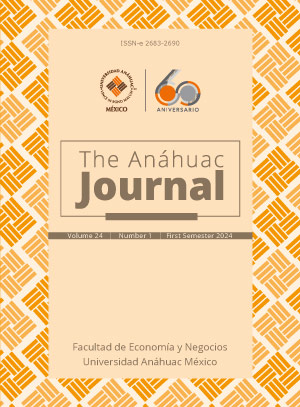Estudio de causalidad sobre problemas de inclusión financiera con técnicas de ciencia de datos: el caso de México
Contenido principal del artículo
Resumen
El presente artículo explora las causas de la inclusión financiera entre la población mexicana. Con datos de la Encuesta Nacional de Inclusión Financiera (ENIF) (INEGI, 2021) desarrolla dos modelos de aprendizaje automático con el objetivo de identificar a individuos que forman parte del sistema financiero. Estos modelos son evaluados valiéndose tanto de metodologías de inteligencia artificial como de pruebas estadísticas de significancia tradicionales. Los hallazgos sugieren que factores como nivel educativo, ingreso mensual, preferencias orientadas hacia el futuro sobre las presentes, capacidad de ahorro y acceso a teléfonos inteligentes son impulsores significativos que aumentan la probabilidad de inclusión financiera. En consecuencia, existe un potencial para la implementación de políticas públicas dirigidas a incentivar a los individuos para que adopten voluntariamente servicios financieros formales.
Downloads
Detalles del artículo
Sección

Esta obra está bajo una licencia internacional Creative Commons Atribución-NoComercial-CompartirIgual 4.0.
The Anáhuac Journal se distribuye bajo Licencia Creative Commons Atribución-NoComercial-CompartirIgual 4.0 Internacional.
Cómo citar
Referencias
Arora, R. U. (2014). Access to finance: An empirical analysis. The European Journal of Development Research, 26(5), 798–814. https://doi.org/10.1057/ejdr.2013.50 DOI: https://doi.org/10.1057/ejdr.2013.50
Beck, T., Demirguc-Kunt A., & Martinez Peria, M. S. (2007). Reaching out: Access to and use of banking services across countries. Journal of Financial Economics, 85(1), 234–266. https://doi.org/10.1016/j.jfineco.2006.07.002 DOI: https://doi.org/10.1016/j.jfineco.2006.07.002
Berkson, J. (1944). Application of the Logistic Function to Bio-Assay. Journal of the American Statistical Association, 39(227). https://doi.org/10.2307/2280041 DOI: https://doi.org/10.2307/2280041
Bruhn, M. & Love, I. (2014). The real impact of improved access to finance: Evidence from Mexico. The Journal of Finance, 69(3), 1347–1376. https://doi.org/10.1111/jofi.12091 DOI: https://doi.org/10.1111/jofi.12091
Community Reinvestment Act (1977). Federal Reserve.
Conroy, J. (2005). APEC and financial exclusion: missed opportunities for collective action? Asia Pacific Development Journal, 12(1), 53–79. DOI: https://doi.org/10.18356/339ee7fc-en
Cruz-García, P., Dircio-Palacios Macedo, M. del C. & Tortosa-Aucina, E. (2020). Financial inclusion and exclusion across Mexican municipalities. Regional Science Policy & Practice, 13(5), 1496–1526. https://doi.org/10.1111/rsp3.12388 DOI: https://doi.org/10.1111/rsp3.12388
De la Cruz Gallegos, J. L. & Alcántara Lizárraga, J.A. (2011). Crecimiento económico y el crédito bancario: un análisis de causalidad para México. Revista de Economía, 28(77), 9–38. DOI: https://doi.org/10.33937/reveco.2011.25
Dircio-Palacios Macedo, M. del C., Cruz-García, P., Hernández-Trillo, F. & Tortosa-Ausina, E. (2023). Constructing a financial inclusion index for Mexican municipalities. Finance Research Letters, 52(C), article 103368. https://doi.org/10.1016/j.frl.2022.103368 DOI: https://doi.org/10.1016/j.frl.2022.103368
Demirguc-Kunt, A. & Klapper, L. (2012). Measuring financial inclusion: The global findex database (No. 6025). The World Bank. DOI: https://doi.org/10.1596/1813-9450-6025
James, G., Witten, D., Hastie, T. & Tibshirani, R. (2017). An Introduction to Statistical Learning with Application in R. Springer.
Jamil, A. R. M., Law, S.H., Khair-Afham, M.S. & Trinugroho, I. (2024). Financial inclusion and income inequality in developing countries: The role of aging populations. Research in International Business and Finance, 67(PA). https://doi.org/10.1016/j.ribaf.2023.1 DOI: https://doi.org/10.1016/j.ribaf.2023.102110
Gujarati, D. & Porter, D. (2009). Basic Econometrics. McGraw-Hill Series Economics.
Huong Tram, Thi Xuan, Lai, Tien Dinh, Huong Nguyen, Thi Truc. (2023). Constructing a composite financial inclusion index for developing economies. The Quarterly Review of Economics and Finance, 87 (257–265). https://doi.org/10.1016/j.qref.2021.01.003
Instituto Nacional de Estadística Geografía e Informática (INEGI). (2021). Encuesta Nacional de Inclusión Financiera (ENIF) 2021.
Johnson, S. & Arnold, S. (2014) Inclusive financial markets: is transformation under way in Kenya? Development Policy Review, 32 (5), 639–642. https://doi.org/10.1111/j.1467-7679.2012.00596.x DOI: https://doi.org/10.1111/j.1467-7679.2012.00596.x
King, R. G. & Levine, R. (1993) Finance and growth: Schumpeter might be right. The Quarterly Journal of Economics, 108(3), 713–737. https://doi.org/10.2307/2118406 DOI: https://doi.org/10.2307/2118406
Leyshon, A. & Thrift, N. (1995). Geographies of financial exclusion: financial abandonment in Britain and the United States. Transactions of the Institute of British Geographers, New Series 20(3), 312–341. https://doi.org/10.2307/622654 DOI: https://doi.org/10.2307/622654
Marín, A. G. & Schwabe, R. (2018). Bank competition and financial inclusion: Evidence from Mexico. Review of Industrial Organization, 55(2), 257–285. https://doi.org/10.1007/s11151-018-9673-5 DOI: https://doi.org/10.1007/s11151-018-9673-5
Mohan, R. (2006). Economic growth, financial deepening, and financial inclusion. Address at the Annual Bankers’ Conference 2006, Hyderabad on November 3, 2006. http://rbidocs.rbi.org.in/rdocs/Speeches/PDFs/73697.pdf
Rangarajan Committee. (2008). Report of the Committee on Financial Inclusion. Government of India.
Sarma, M. (2015). Measuring Financial Inclusion. Economic Bulletin. 35(1), 604–611.
Schuetz, S. & Venkatesh, V. (2020). Blockchain, adoption, and financial inclusion in India: Research opportunities. International Journal of Information Management, 52. https://doi.org/10.1016/j.ijinfomgt.2019.04.009 DOI: https://doi.org/10.1016/j.ijinfomgt.2019.04.009
Schumpeter, J. (1911). The theory of economic development. Harvard University Press.
Segovia, M. A. F. & Cepeda, L. E. T. (2024). Financial development and economic growth: New evidence from Mexican States. Regional Science Policy & Practice, article 100028. https://doi.org/10.1016/j.rspp.2024.100028 DOI: https://doi.org/10.1016/j.rspp.2024.100028
Sun, T. & Wang, X. (2023). Adoption of financial inclusion in a world of depleting natural resources: the importance of information and communication technology in emerging economies. Resources Policy, 85. https://doi.org/10.1016/j.resourpol.2023.103901 DOI: https://doi.org/10.1016/j.resourpol.2023.103901
Tram, T. X. H., Lai, T. D. & Nguyen, T. T. H. (2023). Constructing a composite financial inclusion index for developing economies. Quarterly Review of Economics and Finance, 87, 257–265. https://doi.org/10.1016/j.qref.2021.01.003 DOI: https://doi.org/10.1016/j.qref.2021.01.003
Varian, Hal R. (1992). Microeconomic Analysis. Norton.
WallStreetZen. (2023). Where Did Gen Z Learn About Money. https://www.wallstreetzen.com/blog/genz-money-social-media-survey/
Xi, W. & Wang, Y. (2023). Digital financial inclusion and quality of economic growth. Heliyon, 9. https://doi.org/10.1016/j.heliyon.2023.e19731 DOI: https://doi.org/10.1016/j.heliyon.2023.e19731
Yue, P., Korkmaz, A.G., Yin, Z. & Zhou, H. (2022). The rise of digital finance: financial inclusion or debt trap? Finance Research Letters, 47(A). https://doi.org/10.1016/j.frl.2021.102604 DOI: https://doi.org/10.1016/j.frl.2021.102604

